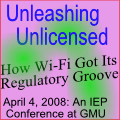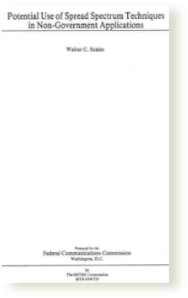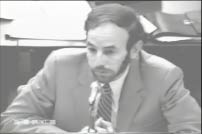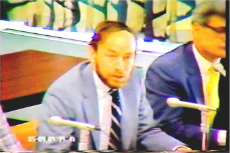Early Civil Spread Spectrum History
Wi-Fi History and CDMA History
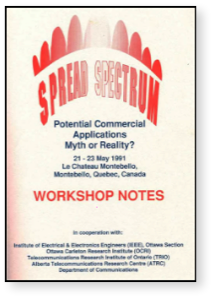
Like computer technology, spread spectrum technology has a long complex history with no clear single "eureka" moment or inventor. The Hedy Lamarr story of invention is charming, has some historic basis, but appears to have been a technological dead end. Military R&D at MIT Lincoln Laboratory, Sylvania Electronic Systems, and Magnavox Government and Industrial Electronics for jam-resistant and covert communications systems produced many of the key technical details and early military systems such as the AN/ARC-70 and AN/ARC-90. However, parallel radar technology -- where the concept is called "phase coding" -- also had an impact. But since most early work was classified, the origins were confusing for a long time.
The 1976 publication of Spread Spectrum Systems by Robert Dixon was a significant milestone in the commercialization of this technology. Previous publications were either classified military reports or academic papers on narrow subtopics. Dixon's book was the first comprehensive unclassified review of the technology and set the stage for increasing research into commercial applications.
I got involved in spread spectrum technology in depth in 1975-79 while working at the Institute for Defense Analyses, a Pentagon think-tank, on options to protect military units from communications jamming. Events in the 1973 Mid East War had raised concern in the US military about this issue - which had been neglected since WWII.
The late 1970's were an era of deregulation for the Federal Government. The thinking of Alfred E. Kahn on the benefits of deregulation were influential throughout Washington. FCC Chairman Charles Ferris wanted to decrease the role of FCC and stimulate new services and technologies. He was concerned about promising technologies that were being held back by anachronistic regulation that discouraged their consideration and the capital formation necessary for their further development.
Ferris' new technical czar, former (D)ARPA Director Stephen Lukasik, and I met in the summer of 1979 at an Army-sponsored meeting on electronic warfare issues. We had met several years earlier when he was Director of ARPA (now DARPA) and I was a junior Air Force officer spending his money on underground nuclear test detection research. Interested in my thoughts on EW issues, he asked what new technologies should the FCC be thinking about for removing unnecessary barriers. Thinking for a while, I responded: spread spectrum, adaptive antennas, and millimeter waves (frequencies >30 GHz). I soon had my ticket out of the military industrial complex and into FCC.
The 1980's
Initial commercial use of spread spectrum began in the 1980s in the US with three systems. Each was authorized by FCC based on narrow specific circumstances. Two were satellite systems in which the satellite operator already had effective ownership and management of the frequencies involved. But general spectrum management policies in the US and elsewhere made spread spectrum use in other contexts doubtful and the general technical consensus was that CDMA had inefficient in the real world.
The first systems were:
- Equatorial Communications System's very small aperture (VSAT) satellite terminal system for newspaper newswire services.
- Del Norte Technology's radionavigation system for navigation of aircraft for crop dusting and similar applications
- Qualcomm's OmniTRACS system for communications to trucks
(In the Qualcomm and Equatorial systems, spread spectrum enabled small antennas that viewed more than one satellite to be used since the processing gain of spread spectrum eliminated interference. The Del Norte system used the high bandwidth of spread spectrum to improve location accuracy.)
Chairman Ferris approved the spread spectrum initiative that Dr. Lukasik and I proposed to him. The basic goal was to remove regulatory barriers to spread spectrum and CDMA in order to encourage R&D on practical systems, while maintaining interference protection for conventional users. As specific systems were developed they could be considered on their merits. But if FCC did nothing it was feared that the "regulatory risk" of approaching the FCC "cold" was so great that it discouraged investment and R&D.
The MITRE report, written by Walt Scales, has the first written reference to the possible use of the ISM bands for spread spectrum commercial applications (p. 3-25 to 3-29). However, it does not explicitly mention unlicensed use of these bands as the report focused on technical issues.
Following the MITRE report, FCC staff prepared a Notice of Inquiry under my direction and it was approved on June 30, 1981, initiating Docket 81-413. A parallel proceeding, Docket 81-414, examined spread spectrum in the context of amateur radio.
[Edited slightly for duration limit]
Notice of Inquiry Text
Regrouping, we drafted a May 21, 1984 Notice of Proposed Rulemaking that narrowed the proposals and included the specific context unlicensed use of the 3 ISM bands. A major reason was to give spread spectgrum someplace to start since everywhere else there was a NIMBY problem. (Oddly, the cordless phone industry opposed the proposals fearing that FCC would act on it and ignore their proposal for more spectrum for mediocre FM-based cordless phones at 48 MHz. Ironically, spread spectrum phoes have now mostly replaced 48 MHz phones in the US marketplace.)
The world's first general authorization for civil spread spectrum was in the May 1985 in FCC Docket 81-413. This included the rules that Wi-Fi, Bluetooth, and the majority of cordless phones sold in the US operate under.
Presentation by Dr. Marcus followed by Commission discussion and adoption (Note remarks by Chairman Fowler at 3:53 - 4:15 of video. Slightly edited slightly for duration limit.]
Docket 81-413
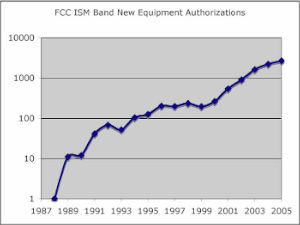
Unfortunately the internal FCC response to May 1985 decision was not positive. The new type of unlicensed system that as created was threatening to many people both inside and outside of FCC. As a result there was a major reorganization of my office that seemed engineered to displace me and within 6 months of the decision I was transferred to an ill defined position in the enforcement arm of the FCC where I was to stay for about 7 years until I rode back "on a millimeter wave".
A few of the first few models of spread spectrum equipment authorized under these rules were designed with some rather odd details that lowered their manufacturing cost but eliminated most of all of the processing gain required by the rules. (For example one system used frequency hopping in the transmitter but had a fixed tuned receiver that listened to only one frequency.) Other manufacturers complained to FCC about such systems and pressed for a more detailed definition and measurement of processing gain. I was opposed to such a change and felt that market forces would drive such system out of the market due to their poor performance. However, I was in "internal exile" at that time due to industry hostility from the 1985 decision and had no impact on the decision taken in Docket 89-354 which began in August 1989 and ended in July 1990. As a result of this proceeding, the original 1985 rules were amended with a new provision, later codified (numbered) as 15.247(e):
(e) The processing gain of a direct sequence system shall be at least 10 dB. The processing gain shall be determined from the ratio in dB of the signal to noise ratio with the system spreading code turned off to the signal to noise ratio with the system spreading code turned on, as measured at the demodulated output of the receiver.
It is ironic that this provision - not in the original 1985 rules - came close to blocking Wi-Fi's access to market as questions were raised inside and outside FCC about whether the 802.11b waveform actually complied. No one formally opposed approval of the Wi-Fi waveform - not even the HomeRF community that was developing Wi-Fi-like alternative at the time. In what was euphemistically called by a lawyer for one of the parties "an undocketed proceeding", FCC decided not to pursue this issue. The way for Wi-Fi was cleared!
A few years later HomeRF asked for a rule change to permit increased data rates and the Wi-Fi community strongly opposed the change at FCC, delaying any action for more than a year. During this period Wi-Fi got a strong market foothold and HomeRF "fell by the wayside".
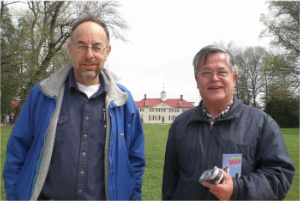
With Vic Hayes (r), original chair of 802.11, at Mount Vernon after the April 2008
Wi-Fi History Conference
Economist article on Wi-Fi history (June 2004)
(Copy in a Puerto Rican blog)
Presentation on the early history civil spread spectrum at the March 2004 meeting of IEEE 802 in Orlando shortly before retiring from FCC. (1.6 MB .ppt document)
The Civil Use of Spread Spectrum and the Success of Wi-Fi, 10th Economics of Infrastructures Conference, TU Delft, Delft, The Netherlands, 5/31/07 (Video of presentation is available on website along with slides.)
"Wi-Fi and Bluetooth - The Path from Carter and Reagan-era Faith in Deregulation to Widespread Products Impacting Our World", THE GENESIS OF UNLICENSED WIRELESS POLICY :An Information Economy Project Conference, 4/08 (Note this is the most detailed description of early ISM band/Wi-Fi policy making that I have even written)
Favorite Quotes:
The Economist, June 12, 2004, p. 26
"But the FCC, prompted by a visionary engineer on its staff, Michael Marcus, took three chunks of spectrum from the ISM bands and opened them up to communications engineers"
Introductory comments by Former FCC Chairman Mark Fowler at at George Mason University 4/08 conference of Wi-Fi History:
"Despite these naysayers, Mike Marcus persisted. I clearly recall the meeting with Mike in which he convinced me that I should put the adoption of these new policies before the entire Commission for an up or down vote. I did so, and the Commission adopted the new Part 15 rules. "
Quote from the 802. 11 minutes Fort Lauderdale, FL November 11-15, 1991
(The presentation at WPI is here at p. 42-48)
"In conclusion
• "Mike, I have shown the dramatic impact your actions at the FCC made to:
– The public
– The workforce
– The economy
– The world"
• "We would like to thank you for your effort" - Slide 30
"Michael Marcus is an improbable revolutionary. An MIT-trained electrical engineer, he spent three years as an Air Force officer during the Vietnam war, designing communications systems for underground nuclear test detection at a time when the ARPANET—the original, military-sponsored version of the Internet—was first in use. ...In the summer of 1979, Marcus attended an Army electronic warfare workshop. As was typical at Army events, attendees were seated alphabetically. Marcus’s neighbor was Steve Lukasik, the FCC’s chief scientist. Lukasik had been Director of ARPA during the development of the ARPANET and then an ARPANET visionary at Xerox. He came to the FCC, not generally considered a technologically adventurous agency, because Carter administration officials were toying with the idea that existing federal regulations might be stifling innovation. Lukasik asked Marcus what he thought could stimulate growth in radio communications. Marcus answered, among other things, “spread spectrum.” His engineering was sound, but not his politics. People would not like this idea."
"... others familiar with spread spectrum lore paint a compelling picture of Marcus, who emerges as a regulatory Robin Hood, the guy who saw the potential of unlicensed spread spectrum devices to liberate radio from the ruling forces."
Broadband Wireless Internet Access / WiMAX News,11/23/07
" One of my favorite blogs, and a perfect illustration of how blogs have completely changed the publishing industry by allowing unfiltered propagation of incredibly valuable insight is SpectrumTalk by Michael Marcus. Those who know Marcus' work at the FCC hold him in reverence; at least I do, especially for his amazing prescience of the potential of license-exempt spectrum allocation and spread spectrum technology."
Impact of Wi-Fi/ISM Band
Microsoft statement on economic value of Wi-Fi spectrum use, March 2, 2017
"In 2014, Raul Katz, a professor at Columbia University, estimated that by this year unlicensed spectrum would contribute $547.22 billion in economic surplus annually and nearly $50billion to the annual GDP. He arrived at that estimate by building on hi historical assessment of unlicensed spectrum’s economic value in 2013 ($222.4 billion in total economic value and $6.7 billion contributed to the GDP) and analyzing two key drivers of growth in the area."
Op-ed by FCC Comm. Mike O'Reilly 6/19/17 "This World Wi-Fi Day, let's celebrate the progress we've made"
"To say that Wi-Fi is a critical component of Internet access in today’s always-connected society doesn’t do it justice. Every day, Wi-Fi handles more than half of all Internet traffic and brings wireless Internet availability to billions and billions of devices. It connects individuals to home networks and throughout work settings. It’s nearly omnipresent and often offered for free in coffee shops, libraries, airports, universities, hotels and many other places, delivering fast download speeds and once unimaginable bandwidth capacity. And, we can’t ignore its contributions to overall economic productivity, which can be likely measured in the hundreds of billions or trillions of dollars produced and man-hours saved."

---Regulatory Reform as a Tool for Bridging the Digital Divide, OECD, 2004
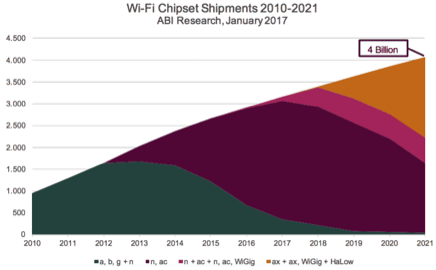
---Regulatory Reform as a Tool for Bridging the Digital Divide, OECD, 2004
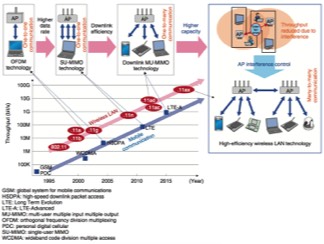

July 2011 data from Bluetooth SIG
Acknowledgements and thanks to those who worked with me on original spread spectrum rulemaking:
FCC Chairman Charles Ferris - who had the vision to gather a team on technology and policy and challenge them to remove barriers to new technology.
Stephen Lukasik, former Chief Scientist of FCC - who had the vision to hire me, challenged me to identify the roadblocks to new radio technology, and supported me during the early stages.
Elliot Maxwell - who supported the vision and tried to teach me how Washington really worked.
Robert Powers - successor of Steve Lukasik as FCC Chief Scientist, who continued to support the initiative even though it proved not to be "career enhancing" for either of us in the short term.
Marjorie "Peggy" Reed Greene - successor of Elliot Maxwell as Deputy Chief Scientist who was always a source of pragmatic advice.
FCC Chairman Mark Fowler - who recognized that this type of deregulation also fit the Reagan agenda and supported it even though industry was rather negative.
Arthur Feller, Michael Kennedy, Joseph McNulty, John Reed and Dan Yates - who worked with me to draft the FCC agenda items that implemented the policy.
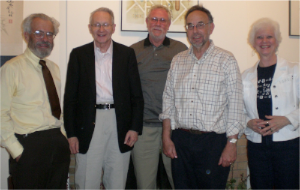
ISM band silver jubilee reunion May 2010
Robert Powers, Stephen Lukasik, Elliot Maxwell, MJM, Marjorie "Peggy" Reed Greene
173-89-67 Box 29
173-89-73 Box 10
173-89-74 Box 49
NN3-173-99-002

